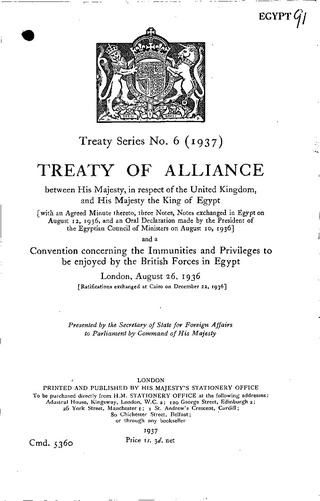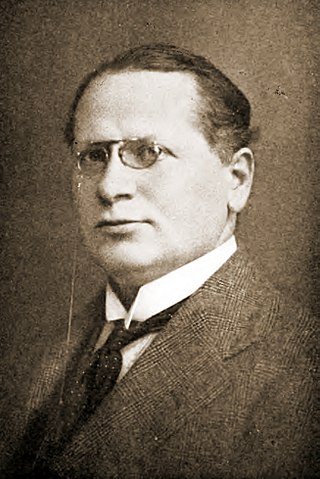The protocol for the reconstruction of Austria was an agreement concluded on 4 October 1922 between the government of Austria and the governments of the United Kingdom, France, Italy and Czechoslovakia, which provided for a gradual reconstruction of the Austrian economy under League of Nations supervision. It was registered in the League of Nations Treaty Series on the same day. The Spanish government acceded to the protocol on 3 November 1922.
The protocol consisted of three declarations, all issued on the same date.
In Declaration No. 1, the signatory parties undertook not to violate Austrian territorial or economic independence. [1]
Declaration No. 2 regulated the foreign loans to be granted to the Austrian government and established a Committee of Control, consisting of the other signatory parties, to overlook the allocations of funds during reconstruction. [2]
Declaration No. 3 granted the Austrian government the time required to arrange internal legislation to conform to Declaration No. 2, as well as the right to appeal certain decisions made by the Committee of Control. [3]
The 1922 protocol was supplemented by the "Austrian Protocol" signed on 15 July 1932, under which the governments of Belgium, Britain, France, Italy and the Netherlands undertook to lend the Austrian government 300,000,000 Austrian schillings for a period of 20 years. [4]

The Potsdam Agreement was the agreement among three of the Allies of World War II: the United Kingdom, the United States, and the Soviet Union after the war ended in Europe on 1 August 1945 and it was published the next day. A product of the Potsdam Conference, it concerned the military occupation and reconstruction of Germany, its border, and the entire European Theatre of War territory. It also addressed Germany's demilitarisation, reparations, the prosecution of war criminals and the mass expulsion of ethnic Germans from various parts of Europe. France was not invited to the conference but formally remained one of the powers occupying Germany.
The Protocol for the Prohibition of the Use in War of Asphyxiating, Poisonous or other Gases, and of Bacteriological Methods of Warfare, usually called the Geneva Protocol, is a treaty prohibiting the use of chemical and biological weapons in international armed conflicts. It was signed at Geneva on 17 June 1925 and entered into force on 8 February 1928. It was registered in League of Nations Treaty Series on 7 September 1929. The Geneva Protocol is a protocol to the Convention for the Supervision of the International Trade in Arms and Ammunition and in Implements of War signed on the same date, and followed the Hague Conventions of 1899 and 1907.

The Hague Conventions of 1899 and 1907 are a series of international treaties and declarations negotiated at two international peace conferences at The Hague in the Netherlands. Along with the Geneva Conventions, the Hague Conventions were among the first formal statements of the laws of war and war crimes in the body of secular international law. A third conference was planned for 1914 and later rescheduled for 1915, but it did not take place because of the start of World War I.

The Little Entente was an alliance formed in 1920 and 1921 by Czechoslovakia, Romania and the Kingdom of Serbs, Croats and Slovenes with the purpose of common defense against Hungarian revisionism and the prospect of a Habsburg restoration in Austria or Hungary. France supported the alliance by signing treaties with each member country. The rapid growth of German power caused its collapse in 1938, and it never went into wartime operation.

The Treaty of Sèvres was a 1920 treaty signed between the Allies of World War I and the Ottoman Empire. The treaty ceded large parts of Ottoman territory to France, the United Kingdom, Greece and Italy, as well as creating large occupation zones within the Ottoman Empire. It was one of a series of treaties that the Central Powers signed with the Allied Powers after their defeat in World War I. Hostilities had already ended with the Armistice of Mudros.

The Anglo-Egyptian Treaty of 1936 was a treaty signed between the United Kingdom and the Kingdom of Egypt.

The causes of World War II have been given considerable attention by historians. The immediate precipitating event was the invasion of Poland by Nazi Germany on September 1, 1939, and the subsequent declarations of war on Germany made by Britain and France, but many other prior events have been suggested as ultimate causes. Primary themes in historical analysis of the war's origins include the political takeover of Germany in 1933 by Adolf Hitler and the Nazi Party; Japanese militarism against China, which led to the Japanese invasion of Manchuria and the Second Sino-Japanese War; Nationalist uprising in Spain, which led to the Spanish Civil War; or Italian aggression against Ethiopia, which led to the Second Italo-Ethiopian War.

In the history of the 20th century, the interwar period lasted from 11 November 1918 to 1 September 1939 – from the end of World War I to the beginning of World War II. It was relatively short, yet featured many social, political, and economic changes throughout the world. Petroleum-based energy production and associated mechanisation led to the prosperous Roaring Twenties, a time of social and economic mobility for the middle class. Automobiles, electric lighting, radio, and more became common among populations in the first world. The era's indulgences were followed by the Great Depression, an unprecedented worldwide economic downturn that severely damaged many of the world's largest economies.

The 1926 Slavery Convention or the Convention to Suppress the Slave Trade and Slavery is an international treaty created under the auspices of the League of Nations and first signed on 25 September 1926. It was registered in League of Nations Treaty Series on 9 March 1927, the same day it went into effect. The objective of the convention is to confirm and advance the suppression of slavery and the slave trade and was extended in 1956 with the Supplementary Convention on the Abolition of Slavery, under the auspices of the United Nations.

The Litvinov Protocol is the common name of an international peace treaty concluded in Moscow on February 9, 1929. Named after the chief Soviet diplomat moving the negotiations forward, Maxim Litvinov, the treaty provided for immediate implementation of the Kellogg-Briand Pact by its signatories, thereby formally renouncing war as a part of national foreign policy.

The London and Paris Conferences were two related conferences held in London and Paris during September–October 1954 to determine the status of West Germany. The talks concluded with the signing of the Paris Agreements, which granted West Germany some sovereignty, ended the occupation, and allowed its admittance to NATO. Furthermore, both West Germany and Italy joined the Brussels Treaty on 23 October 1954. The Agreements went into force on 5 May 1955. The participating powers included France, the United Kingdom, Belgium, the Netherlands, Luxembourg, West Germany, Italy, Canada, the United States, and remaining NATO members.

The Minority Treaties are treaties, League of Nations mandates, and unilateral declarations made by countries applying for membership in the League of Nations that conferred basic rights on all the inhabitants of the country without distinction of birth, nationality, language, race or religion. The country concerned had to acknowledge the clauses of the treaty as fundamental laws of state and as obligations of international concern placed under the guarantee of the League of Nations. Most of the treaties entered into force after the Paris Peace Conference.

Relevant events began regarding the Baltic states and the Soviet Union when, following Bolshevist Russia's conflict with the Baltic states—Lithuania, Latvia and Estonia—several peace treaties were signed with Russia and its successor, the Soviet Union. In the late 1920s and early 1930s, the Soviet Union and all three Baltic States further signed non-aggression treaties. The Soviet Union also confirmed that it would adhere to the Kellogg–Briand Pact with regard to its neighbors, including Estonia and Latvia, and entered into a convention defining "aggression" that included all three Baltic countries.
The Agreement between the Allied and Associated Powers with Regard to the Contribution to the Cost of Liberation of the Territories of the Former Austro-Hungarian Monarchy was concluded on 10 September 1919 and complemented the Saint-Germain peace treaty with Austria.
The Barcelona Convention and Statute on the Regime of Navigable Waterways of International Concern is a multilateral treaty that was concluded at Barcelona on 20 April 1921. Its purpose is to ensure freedom of navigation in waterways which bear international significance. It was registered in League of Nations Treaty Series on 8 October 1921. It went into effect on 31 October 1922. The convention is still in force.
The Protocol for the Reconstruction of Hungary was an agreement concluded on 14 March 1924 between the government of Hungary and the governments of Great Britain, France, Italy, Romania, Yugoslavia and Czechoslovakia, providing for a gradual reconstruction of the Hungarian economy under League of Nations supervision.

The Rome Protocols were a series of three international agreements concluded in Rome on 17 March 1934 between the governments of Austria, Hungary and Italy. They were signed by Italian Prime Minister Benito Mussolini, Austrian Chancellor Engelbert Dollfuss and Hungarian Prime Minister Gyula Gömbös. All of the protocols went into effect on 12 July 1934 and were registered in League of Nations Treaty Series on 12 December 1934.

The Sino-British Treaty for the Relinquishment of Extra-Territorial Rights in China, or the Sino-British New Equal Treaty, was a bilateral treaty concluded between the British and the Chinese government in Chongqing on 11 January 1943. The formal name of the treaty was Treaty Between His Majesty in Respect of the United Kingdom and India and His Excellency the President of the National Government of the Republic of China for the Relinquishment of Extra-Territorial Rights in China and the Regulation of Related Matters.
International relations (1919–1939) covers the main interactions shaping world history in this era, known as the interwar period, with emphasis on diplomacy and economic relations. The coverage here follows the diplomatic history of World War I and precedes the diplomatic history of World War II. The important stages of interwar diplomacy and international relations included resolutions of wartime issues, such as reparations owed by Germany and boundaries; American involvement in European finances and disarmament projects; the expectations and failures of the League of Nations; the relationships of the new countries to the old; the distrustful relations between the Soviet Union and the capitalist world; peace and disarmament efforts; responses to the Great Depression starting in 1929; the collapse of world trade; the collapse of democratic regimes one by one; the growth of economic autarky; Japanese aggressiveness toward China; fascist diplomacy, including the aggressive moves by Fascist Italy and Nazi Germany; the Spanish Civil War; the appeasement of Germany's expansionist moves toward the Rhineland, Austria, and Czechoslovakia, and the last, desperate stages of rearmament as another world war increasingly loomed.

On 23 October 1936, a nine-point protocol was signed by Fascist Italy and Nazi Germany in Berlin. It was the first concrete expression of the Italo-German rapprochement that began earlier that year. It was signed by the foreign ministers Galeazzo Ciano and Konstantin von Neurath. On the same day in Berlin, the Anti-Comintern Pact between Germany and Japan was initialed by Ambassador-at-Large Joachim von Ribbentrop and Ambassador Kintomo Mushanokoji.